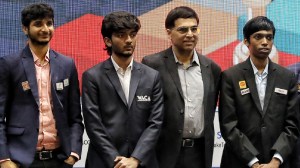- India
- International
Cues Indians can take from a Bangladeshi architect
Marina Tabassum on working with the local, centrality of the central space in buildings, and creating a seed fund to help women build
 Panigram Resort (Courtesy: Marina Tabassum Architects)
Panigram Resort (Courtesy: Marina Tabassum Architects)
Architect Marina Tabassum did not want Dhaka’s Bait Ur Rouf Mosque to look like one. Without domes and minarets, she set it on a plinth, designing porous brick walls that would shelter a prayer hall and other ancillary activities. By inserting a cylindrical volume into a square and turning it at a 13-degree angle, Tabassum created light courts on all four sides of the hall. As the sun sweeps into these courts, the concrete ceiling with its dotted punctures allows dappled light to move through the floor. The mosque won Tabassum the Aga Khan Award for Architecture (2016). Bangladesh-based Tabassum was in Mumbai recently for a conference organised by the School of Environment and Architecture.
“My fascination with light first emerged when I visited Louis Kahn’s National Assembly Building in Dhaka. He works with light so beautifully that it’s both sensual and spiritual. I was in high school when I first saw it in 1982. As I walked around the ambulatory space, it was surreal, something I hadn’t seen before. The other most visual memory was of being in Hagia Sophia, Istanbul. I was awestruck by the play of light and wondered how it could create such a powerful presence by being so silent. Since then, I try, in my own capacity, to use light in my buildings,” says Tabassum, 49.
The client for the mosque was her grandmother who gave the land for the building. With a very tight budget in this dense neighbourhood, Tabassum didn’t have the money for the finishing touches. She was the manager, fundraiser, designer and builder in this project. Light was an ornament in this space, which dips, chases and plays differently at different times of the year.
 Marina Tabassum (Courtesy: Shahrear Kabir Heemal)
Marina Tabassum (Courtesy: Shahrear Kabir Heemal)
Tabassum belongs to the group of architects that was inspired by architect Muzharul Islam’s call for a “place-responsive architecture” in the late ’80s. A student from the Bangladesh University of Engineering and Technology, she was led by her drive to understand through architecture what it meant to be contemporary and Bengali. Soon, after graduation in 1995, Tabassum began URBANA, a design firm with architect Kashef Chowdhury. Together, they designed numerous projects that won them awards, both in Bangladesh and abroad. The most well-known among them is the Swadhinata Stambha (Independence Monument) and the Liberation War Museum. After nearly 10 years, she started her own practice, Marina Tabassum Architects.
The question of “what to hold on to, what to abandon and what to adopt” was central to those of her generation as they began building away from the shadows of European and American architects. For Tabassum, therefore, there is this tension of acceptance and resistance in her designs. “I see buildings more as a being, something that has a soul that you can’t see. I put a central void, a certain emptiness in my buildings. It’s this central space that gives the building its spirit. She used this idea in the Venice Biennale for Architecture in 2018, where the theme of the courtyard was central to her installation. Called the Wisdom of the Land, it was emblematic of her childhood home in Dhaka, where the courtyard was always abuzz with the theatre of life. It also reverberated with idioms she drew out of her project of the Panigram Resort in Jessore district, about 70 km away from the Sundarbans. A community-led initiative, it had local people involved in the building of the resort. At the Biennale, she stencilled a house out of fine-steel lines and allowed the craft of the land to be highlighted, from ceramic granaries to a boat made from a palm tree.

 Museum of Independenc
Museum of Independenc
“When we began work on Panigram about five years ago, I felt, as an architect with a formal education, I didn’t have the answers the project posed. The client’s brief called for a socially, environmentally-responsible project. We began by documenting the village homesteads and interacting with the locals. Our research into the land and context unearthed wisdoms of living symbiotically with nature, that became the inspiration for the project. The entire village was connected through a series of courtyards; around which houses are gathered. The courtyards are the most vibrant social, communal and private space. Our enquiry into the building technique of mud houses revealed their lack of pride in their way of living. When the villagers understood we were going to build our cottages in mud, they were disappointed and surprised. Mud, for them, was a material for the poor. We wondered how we could reinstall the pride of place and began to involve them in the making of the resort. And thus began our interactions with the villagers. It became a process of reciprocity. While they helped us build the resort with locally-sourced materials and techniques, we helped them with our technological knowledge of building hygienic kitchens and toilets,” she says.
As Bangladesh’s economic growth gathered steam, so did people’s aspirations. Those around the resort wanted to move from mud to brick houses. They, however, lacked the expertise and skill, which is when Tabassum with her team stepped in. Having worked with a group called Platform for Community Action and Architecture, the way forward was to set up a savings group for the women. By saving $1 a week, they could create a seed fund, which would help them build according to their requirements. It was a co-creating exercise where the architect became a facilitator or a mediator. “Architecture needs to expand its agency beyond building, to be relevant as a profession in the 21st century. I try to be conscious of that and address my projects accordingly. In this project, I was able to diffuse the image of the ‘architect as the saviour’ to a practice of the collective,” she says.
As Bengal Institute’s academic director, that facilitates research and design programmes in Dhaka, Tabassum, with Kazi Khaleed Ashraf, its director general, trains younger architects to look beyond building objects as their goal, and find ways to expand their agency. “Future architects will need to reinvent the profession. Other ways of doing architecture must be explored in order to restore the balance and repair the environment for continued habitability,” she says.
Must Read
Apr 23: Latest News
- 01
- 02
- 03
- 04
- 05




































